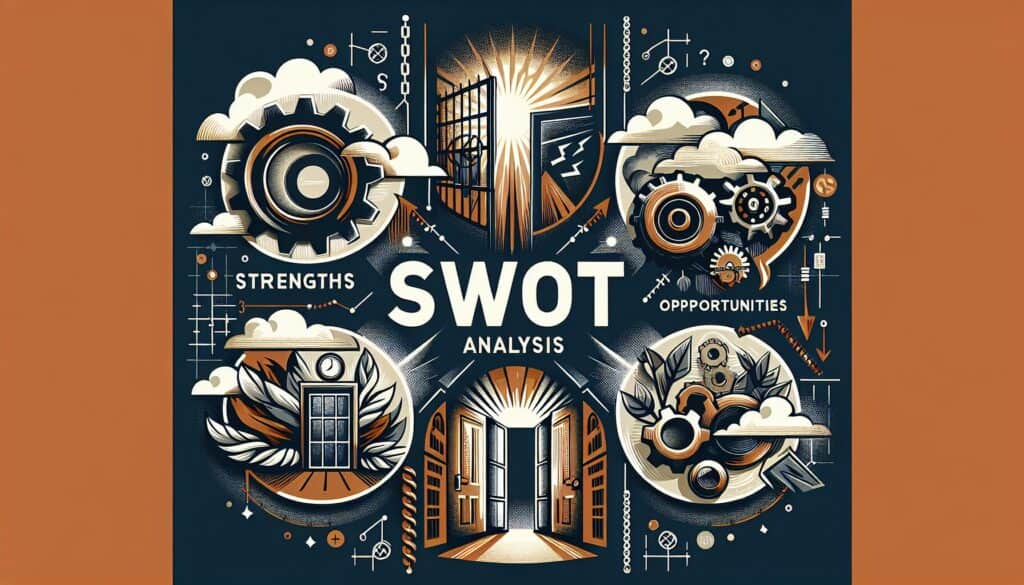Valutare i punti di forza, le debolezze, le opportunità e le minacce di un'organizzazione, di un progetto o di un individuo per informare la pianificazione strategica.
- Metodologie: Clienti e marketing, Ideazione, Progettazione del prodotto
Analisi SWOT

Analisi SWOT
- Reingegnerizzazione dei processi aziendali (BPR), Analisi competitiva, Innovazione, Ricerca di mercato, Gestione del progetto, Gestione del rischio, SWOT, Analisi SWOT
Obiettivo:
Come si usa:
- Vengono identificati ed elencati i punti di forza (attributi interni, positivi), i punti di debolezza (attributi interni, negativi), le opportunità (fattori esterni che possono essere sfruttati) e le minacce (fattori esterni che potrebbero causare problemi), spesso in una matrice a quattro quadranti.
Professionisti
- Struttura semplice per organizzare il pensiero strategico; aiuta a identificare i fattori chiave interni ed esterni; facilita la discussione e la creazione di consenso; può essere applicata in modo ampio a diversi livelli.
Contro
- Può essere soggettivo e basato su opinioni piuttosto che su dati; può generare lunghi elenchi senza una chiara definizione delle priorità; non offre intrinsecamente soluzioni o azioni; è statico e può diventare rapidamente obsoleto.
Categorie:
- Clienti e marketing, Economia, Ideazione, Gestione del progetto
Ideale per:
- Pianificazione strategica, business planning, analisi della concorrenza e valutazione della fattibilità di nuove iniziative.
SWOT L'analisi trova ampia applicazione in vari settori, tra cui quello tecnologico, sanitario, manifatturiero e dei servizi al consumo, e viene spesso impiegata nelle prime fasi di sviluppo di un progetto o nelle sessioni di pianificazione strategica per valutare il potenziale di nuove idee di prodotto o di ingresso nel mercato. I team composti da progettisti di prodotti, ingegneri, professionisti del marketing e strateghi aziendali avviano spesso il processo SWOT, consentendo l'acquisizione di prospettive diverse che possono arricchire il risultato dell'analisi. In settori come quello sanitario, ad esempio, questo metodo è particolarmente utile per il lancio di dispositivi medici innovativi, dove la comprensione delle capacità interne dell'organizzazione e delle esigenze esterne di conformità alle normative e di mercato è fondamentale. La semplicità della matrice incoraggia sessioni di brainstorming che non solo identificano i punti di forza e di debolezza, ma stimolano anche il dibattito su come sfruttare le opportunità non sfruttate - come le tecnologie emergenti o il cambiamento delle preferenze dei consumatori - e mitigare le potenziali minacce, tra cui le pressioni della concorrenza o le flessioni economiche. Le organizzazioni possono impegnarsi nell'analisi SWOT a vari livelli, da una valutazione di alto livello della strategia aziendale a un'analisi mirata di prodotti o iniziative specifiche, consentendo una certa flessibilità nella sua applicazione. Come strumento di pianificazione strategica, promuove l'allineamento tra le parti interessate, portando il consenso sulle priorità e consentendo ai team di formulare piani attuabili basati su una valutazione strutturata delle capacità interne e delle dinamiche del mercato esterno.
Fasi chiave di questa metodologia
- Identificare ed elencare i punti di forza interni rilevanti per il prodotto o l'iniziativa.
- Identificare ed elencare le debolezze interne che potrebbero ostacolare i progressi.
- Identificare ed elencare le opportunità esterne che possono essere sfruttate.
- Identificare ed elencare le minacce esterne che potrebbero costituire un rischio.
- Analizzare le relazioni tra i punti di forza interni e le opportunità esterne.
- Valutare come le debolezze interne possano essere attenuate affrontando le minacce esterne.
- Sviluppare iniziative strategiche basate sull'analisi della matrice SWOT.
Suggerimenti per i professionisti
- Integrare l'analisi dei dati quantitativi con le osservazioni qualitative per aumentare l'affidabilità dei risultati della SWOT.
- Aggiornare regolarmente la matrice SWOT per riflettere i cambiamenti del panorama di mercato e delle capacità interne, favorendo l'agilità delle risposte strategiche.
- Coinvolgere team interfunzionali nel processo di analisi SWOT per scoprire prospettive diverse e ridurre i punti ciechi nella valutazione.
Leggere e confrontare diverse metodologie, raccomandiamo il
> Ampio archivio di metodologie <
insieme ad altre 400 metodologie.
I vostri commenti su questa metodologia o ulteriori informazioni sono benvenuti su sezione commenti qui sotto ↓ , così come tutte le idee o i link relativi all'ingegneria.
Contesto storico
1960
1980
1983
1990
1995
2000
2010
1950
1980
1980
1986
1994
1995
2000
(se la data non è nota o non è rilevante, ad esempio "meccanica dei fluidi", viene fornita una stima approssimativa della sua notevole comparsa)














Post correlati
Gestione delle operazioni di produzione (MOM)
Sistema di esecuzione della produzione (MES)
Piano di controllo della produzione
Test manuali
Schede di valutazione della movimentazione manuale (MAC)
ManTRA (Strumento di valutazione dei rischi delle attività manuali)